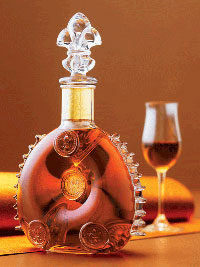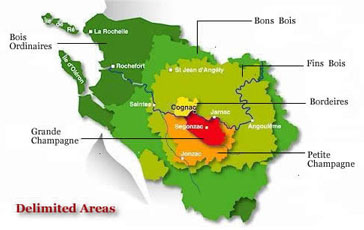|
Bartenders Guide: Cognac & Brandy
"Many people argue in favor of either the tulip or the snifter as the perfect vessel for cognac. I humbly submit that they have forgotten what cognac is for, and that it is best when contained in a kiss." How can I sum up cognac in a page? Obviously, entire works have been devoted to the subject and it is beyond the scope of this site to overreach them. Cognac is a journey that is happily never complete, an endless parade of lovers waiting to embrace you. For those who are serious about getting to know their cognac, I would recommend beginning with understanding the crus, or regions where the grapes are grown. The best known are the Grande Champagne and Petite Champagne, along with the Borderies, Fins Bois, Bons Bois and Bois Ordinaires. Also, I advise looking up Armagnac, which is sometimes viewed as the sleazy twin sister of Cognac. She doesn't come from as nice a neighborhood, but she generally puts out. If you'd like to dig even deeper, another logical step will be Grappa, a fiery Italian brandy.
Cognac and Brandy are the same product, but in order to be called "Cognac", the liquor must come from the Cognac Region of France. It must also be made according to the strict standards of that region. The common French term for the wines which go into cognac is eaux-de-vie (literally, "waters of life") and refers to a double-distilled wine. All cognac is brandy...but not all brandy is cognac. Cognac and Brandy are typically served neat, in a snifter or tulip. You may warm the glass, however this tends to cause the alcohol to vaporize and can ruin the nose of a truly fine cognac. If you are not in a tasting scenario where this is crucial, warming the glass is often viewed as a classy and sophisticated thing to do. Cognac and Brandy are occasionally mixed in cocktails. This can be good. Sadly, some people mix them with Coke. This is bad. That being said, remember it is your job to give your guests what they want, whether it's bad or not. Cognac has a star-rating which is strictly enforced by French law. The official quality grades of cognac are: VS Very Special, or *** (three stars) where the youngest brandy is stored at least two years in cask. VSOP Very Superior Old Pale, where the youngest brandy is stored at least four years in cask, but the average wood age is much older. XO Extra Old, where the youngest brandy is stored at least six, but average upwards of 20 years. There are other grades, such as Napoleon, which is roughly equal to XO in terms of minimum age...meaning it must be at least 6 years old. Don't expect this to be the same quality as a bottle labeled XO, though...there's a big difference between 6 and 20, and most producers using the XO label are on the high end of the scale.
|






